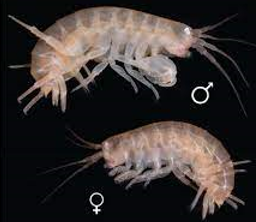Assessing Pyrene Impact on Precopulatory Behaviour: A Cost-effective Time-to-Event Experiment with Parhyale hawaiensis
Ibrahim Lawan
Pyrene
Precopulatory Behaviour
Time-to-Event
Parhyale hawaiensis
Chemosensation
ecotoxicology
environmental contaminants
Disclaimer
The protocol provided here is intended for educational purposes only and should be conducted in appropriate laboratory settings. The developers of this protocol are not liable for any damages or consequences arising from its use. Users should ensure compliance with relevant safety regulations and ethical guidelines when conducting experiments involving live organisms.
Abstract
Understanding the impact of environmental contaminants on chemosensation is crucial for assessing the ecological fitness of aquatic organisms. Here, we present a step-by-step protocol for investigating the chemosensory responses of Parhyale hawaiensis to precopulatory activity following exposure to Pyrene (Pyr), a model polycyclic aromatic hydrocarbon (PAH). We use a time-to-event experimental design to assess the organism's response time to its mating partner in a 70ml petri dish setup under different exposure conditions. This protocol offers a simple approach for conducting cost-effective behavioural ecotoxicology and contributes to our understanding of the interactive effects of contaminants on aquatic organisms.
Steps
Introduction
Chemosensation plays a crucial role in the survival and ecological interactions of aquatic organisms, enabling them to detect and respond to chemical cues in their environment. This chemical communication is used by crustaceans, including amphipods, for various behaviours such as food location, predator detection, mate finding, and physiological indicators (Hardege et al., 2022). However, exposure to environmental contaminants such as polycyclic aromatic hydrocarbons (PAHs) can disrupt chemosensory processes, potentially impairing vital behaviours such as mate-finding and predator avoidance in amphipods (Diamond et al., 2003). Parhyale hawaiensis , a tropical marine amphipod, relies on chemosensation for various behaviours crucial to its survival (Paris et al., 2022), making it an excellent model organism for studying the impact of contaminants on chemosensory function. Therefore, to assess how exposure to Pyrene disrupts chemosensory behaviour related to mate-finding in P. hawaiensis , we conducted a controlled laboratory experiment employing a time-to-event (TTE) scenario. The TTE experiments play a crucial role in understanding the behavioural responses of aquatic organisms to environmental contaminants. This protocol aims to establish a simple and cost-effective standardised methodology for assessing chemosensory responses using a time-to-event experimental approach, focusing on the effects of Pyrene exposure on the pre-copulatory behaviour of Parhyale hawaiensis .
1. Organism Selection and Preparation
- Collect up to ninety-six pairs of adult P. hawaiensis from controlled laboratory culture tanks.
- Carefully select pairs already engaged in pre-copulatory pairing to minimise variability associated with mating preferences.
- Allow the pairs to be separated and keep them isolated for at least one week to allow for egg shedding and prevent new pairings.
- Acclimate organisms separately for 24 hours in individual containers to establish consistent baseline conditions.

How to sex P. hawaiensis gender
2. Exposure Setup
- Prepare about ten (10) replicates of 200-ml glass beakers for each sublethal concentration of Pyrene (0, 2, 10, and 50 µg/L).
- Expose opposite-sex pairs to sublethal concentrations of Pyrene for one week with regular feeding.
- Maintain unexposed pairs under optimal laboratory conditions for P. hawaiensis .
3. Feeding and Exposure Medium Renewal
- Renew exposure medium every three days to ensure consistent exposure levels and minimise confounding effects.
- Calculate feeding rates by quantifying feed consumption for each organism over the one-week exposure period.
4. Moulting Frequency Assessment
- Record moulting frequency by counting exuviae from day-2 to day-7 to evaluate the impact of Pyrene exposure on moulting behaviour.
- Use cumulative count to calculate the moulting frequency for each organism.
5. Preparing for Time-to-Event Assay
- Transfer unexposed partners to clean seawater in 70ml Petri dishes and allow acclimation for at least 6 minutes.
- Ensure all experimental conditions are standardised before initiating the time-to-event assay.
6. Time-to-Event Assay
6.1. Recording Pre-copulatory Behaviour
- Introduce exposed opposite sexes to their unexposed counterparts.
- Record the time taken for an exposed male to initiate pre-copulatory pairing with its unexposed female partner and for an exposed female to accept pairing with its unexposed male partner within a 30-minute time window.
- Consider any failure to initiate or allow pairing within this period as a censored response.
- NB: Responding to precopulatory pairing involves actively chasing the mating partner and attempting to pair for males or resisting to allow pairing for females within the allotted timeframe.
| A | B | C | D | E | F | G | H | I |
|---|---|---|---|---|---|---|---|---|
| Experiment_ID | Treatment | Organism_ID | Sex | Toxicant_Conc_µg/L | Start_Time | End_Time | Response_Time | Status |
| 1 | Control | 1 | Male | 0 | 1000 | 1004 | 4 | 1 |
| 1 | Control | 2 | Male | 0 | 1000 | 1003 | 3 | 1 |
| 1 | Control | 49 | Female | 0 | 1000 | 1009 | 9 | 1 |
| 1 | Control | 50 | Female | 0 | 1000 | 1008 | 8 | 1 |
| ... | ... | ... | ... | ... | ... | … | … | ... |
| 1 | Low | 62 | Female | 2 | 1000 | 1008 | 8 | 1 |
| 1 | Low | 63 | Female | 2 | 1000 | 1007 | 7 | 1 |
| 1 | Low | 13 | Male | 2 | 1000 | 1005 | 5 | 1 |
| 1 | Low | 14 | Male | 2 | 1000 | 1006 | 6 | 1 |
| ... | ... | ... | ... | ... | ... | … | … | ... |
| 1 | Medium | 25 | Male | 10 | 1000 | 1011 | 11 | 1 |
| 1 | Medium | 26 | Male | 10 | 1000 | 1010 | 10 | 1 |
| 1 | Medium | 73 | Female | 10 | 1000 | 1006 | 6 | 1 |
| 1 | Medium | 74 | Female | 10 | 1000 | 1005 | 5 | 1 |
| ... | ... | ... | ... | ... | ... | … | … | ... |
| 1 | High | 37 | Male | 50 | 1000 | 1030 | 30 | 0 |
| 1 | High | 38 | Male | 50 | 1000 | 1023 | 23 | 1 |
| 1 | High | 85 | Female | 50 | 1000 | 1002 | 2 | 1 |
| 1 | High | 86 | Female | 50 | 1000 | 1003 | 3 | 1 |
| ... | ... | ... | ... | ... | ... | … | … | ... |
Sample Table for Recording Time to Precopulatory Behaviour a. Experiment_ID: This column identifies the experiment number or batch in which the data was collected. Each unique experiment is assigned a specific ID.
b. Treatment: This column describes the treatment condition applied to the organisms. It typically includes labels such as "Control" or specific treatment names, indicating whether the organisms were exposed to a toxicant or kept as controls.
c. Organism_ID: This column assigns a unique identifier to each individual organism involved in the experiment. It helps in tracking the responses of each organism across different conditions.
d. Sex: This column indicates the sex of the organism, categorised as "Male" or "Female."
f. Toxicant_Conc_µg/L: This column specifies the toxicant concentration (Pyrene) the organisms were exposed to.
g. Start_Time: This column records the start time of the observation period for the time-to-event (TTE) experiment.
h. End_Time: This column notes the end time of the observation period or the event of interest, such as precopulatory activity.
i. Response_Time: This column calculates the time the organism takes to respond to the mating partner, which is the difference between the End_Time and Start_Time.
j. Status: This column indicates the status of the response, typically coded as binary values where "1" represents an event occurrence (e.g., successful initiation of mating) and "0" represents a censored event (e.g., no response within the allotted time).
7. Data Analysis
7.1. Predictors
-
Feeding rate (FR), sex (Male and Female), moulting frequency, and different toxicant concentrations (0, 2, 10, and 50 µg/L) are considered predictors of the time it takes to respond to precopulatory activity. 7.2 Statistical Analysis
-
Utilise Kaplan-Meier estimates and Cox proportional hazards models to analyse the effects of Pyrene exposure on pre-copulatory behaviour response.
-
Conduct TTE analysis to compare survival curves between exposed and unexposed groups.
-
Explore relationships between predictors and response variables using Cox Proportional Hazards models.
Conclusion
This protocol provides a comprehensive framework for conducting time-to-event experiments in behavioural ecotoxicology. It offers valuable insights into the effects of environmental contaminants on aquatic organisms' reproductive behaviour. We aim to standardise these experimental procedures and data analysis methods so that researchers can enhance the reliability and reproducibility of their findings, advancing our understanding of ecotoxicological impacts on aquatic ecosystems.

